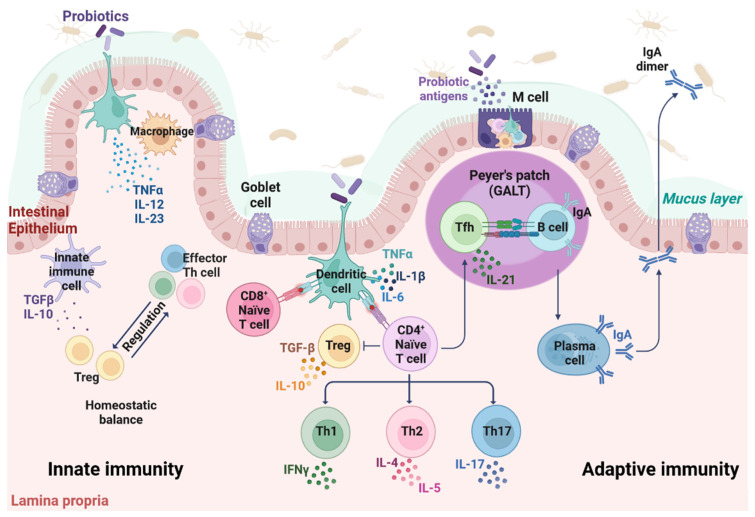Figure 1.
Schematic representation of the interaction between host intestinal immune cells and probiotics. Probiotics play a role in host innate and adaptive immune responses by modulating immune cells such as dendritic cells (DCs), macrophages, and B and T lymphocytes. Interactions between host intestinal cells and probiotics mainly occur at the surface of the intestinal barrier, including the intestinal epithelium and the underlying lamina propria. Intestinal microbiota is separated from the intestinal epithelium by a mucus layer secreted by goblet cells. Consumed probiotic bacteria adhere to intestinal epithelial cells and activate them by pattern recognition receptors (PRRs). Cytokines stimulated by probiotic bacteria lead to the activation of T regulatory (Treg) cells, which maintain immune homeostasis in the intestinal mucosa. Tregs are effective suppressors of the immune response and play a key role in limiting immune response. Intestinal antigens are transferred to DCs via specialized enterocytes known as microfold cells (M cells), which are located in the epithelium overlying Peyer’s patch. Probiotics are processed directly by DCs in lamina propria in the intestinal lumen. Intestinal DCs can activate CD8+/CD4+ naïve T cells and direct helper T cell responses towards Th1, Th2, Th17, or regulatory patterns. The Th1 immune response is mainly characterized by interferon (IFN)-γ production and is involved in cell-mediated immunity. The Th2 immune response includes interleukin (IL)-4, IL-5 release, thus inducing humoral immunity. The Th17 immune response is characterized by IL-17 production. Induction of Tregs releases IL-10 or transforming growth factor (TGF)-β. In addition, probiotics induce maturation of B cells into immunoglobulin (Ig)A-producing plasma cells. Intestinal epithelial cells release cytokines and chemokines, creating a microenvironment in the lamina propria of the intestine that allows the clonal expansion of B cells to produce IgAs. IgAs migrate through the epithelium into the mucus layer where they control bacterial adhesion to the host tissue.

